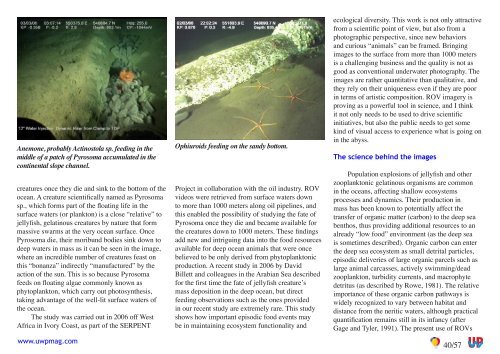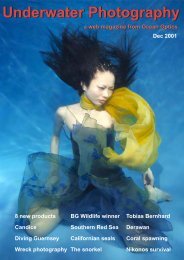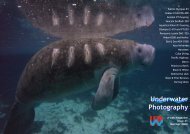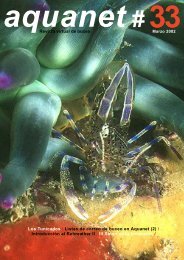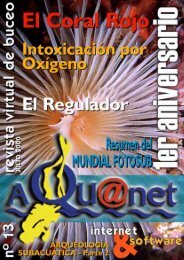Underwater Photography Underwater Photography
Underwater Photography Underwater Photography
Underwater Photography Underwater Photography
You also want an ePaper? Increase the reach of your titles
YUMPU automatically turns print PDFs into web optimized ePapers that Google loves.
Anemone, probably Actinostola sp. feeding in the<br />
middle of a patch of Pyrosoma accumulated in the<br />
continental slope channel.<br />
creatures once they die and sink to the bottom of the<br />
ocean. A creature scientifically named as Pyrosoma<br />
sp., which forms part of the floating life in the<br />
surface waters (or plankton) is a close “relative” to<br />
jellyfish, gelatinous creatures by nature that form<br />
massive swarms at the very ocean surface. Once<br />
Pyrosoma die, their moribund bodies sink down to<br />
deep waters in mass as it can be seen in the image,<br />
where an incredible number of creatures feast on<br />
this “bonanza” indirectly “manufactured” by the<br />
action of the sun. This is so because Pyrosoma<br />
feeds on floating algae commonly known as<br />
phytoplankton, which carry out photosynthesis,<br />
taking advantage of the well-lit surface waters of<br />
the ocean.<br />
The study was carried out in 200 off West<br />
Africa in Ivory Coast, as part of the SERPENT<br />
www.uwpmag.com<br />
Ophiuroids feeding on the sandy bottom.<br />
Project in collaboration with the oil industry. ROV<br />
videos were retrieved from surface waters down<br />
to more than 1000 meters along oil pipelines, and<br />
this enabled the possibility of studying the fate of<br />
Pyrosoma once they die and became available for<br />
the creatures down to 1000 meters. These findings<br />
add new and intriguing data into the food resources<br />
available for deep ocean animals that were once<br />
believed to be only derived from phytoplanktonic<br />
production. A recent study in 200 by David<br />
Billett and colleagues in the Arabian Sea described<br />
for the first time the fate of jellyfish creature’s<br />
mass deposition in the deep ocean, but direct<br />
feeding observations such as the ones provided<br />
in our recent study are extremely rare. This study<br />
shows how important episodic food events may<br />
be in maintaining ecosystem functionality and<br />
ecological diversity. This work is not only attractive<br />
from a scientific point of view, but also from a<br />
photographic perspective, since new behaviors<br />
and curious “animals” can be framed. Bringing<br />
images to the surface from more than 1000 meters<br />
is a challenging business and the quality is not as<br />
good as conventional underwater photography. The<br />
images are rather quantitative than qualitative, and<br />
they rely on their uniqueness even if they are poor<br />
in terms of artistic composition. ROV imagery is<br />
proving as a powerful tool in science, and I think<br />
it not only needs to be used to drive scientific<br />
initiatives, but also the public needs to get some<br />
kind of visual access to experience what is going on<br />
in the abyss.<br />
The science behind the images<br />
Population explosions of jellyfish and other<br />
zooplanktonic gelatinous organisms are common<br />
in the oceans, affecting shallow ecosystems<br />
processes and dynamics. Their production in<br />
mass has been known to potentially affect the<br />
transfer of organic matter (carbon) to the deep sea<br />
benthos, thus providing additional resources to an<br />
already “low food” environment (as the deep sea<br />
is sometimes described). Organic carbon can enter<br />
the deep sea ecosystem as small detrital particles,<br />
episodic deliveries of large organic parcels such as<br />
large animal carcasses, actively swimming/dead<br />
zooplankton, turbidity currents, and macrophyte<br />
detritus (as described by Rowe, 1981). The relative<br />
importance of these organic carbon pathways is<br />
widely recognized to vary between habitat and<br />
distance from the neritic waters, although practical<br />
quantification remains still in its infancy (after<br />
Gage and Tyler, 1991). The present use of ROVs<br />
40/57


